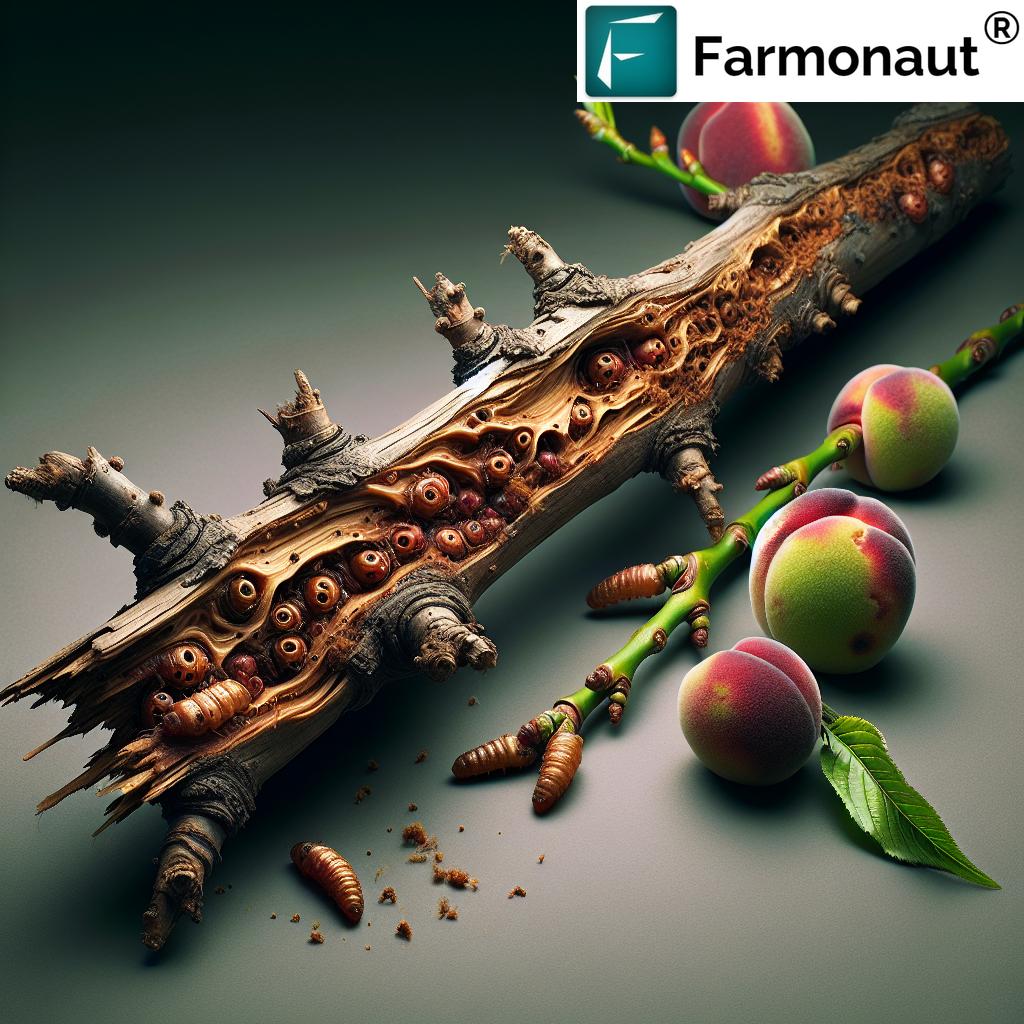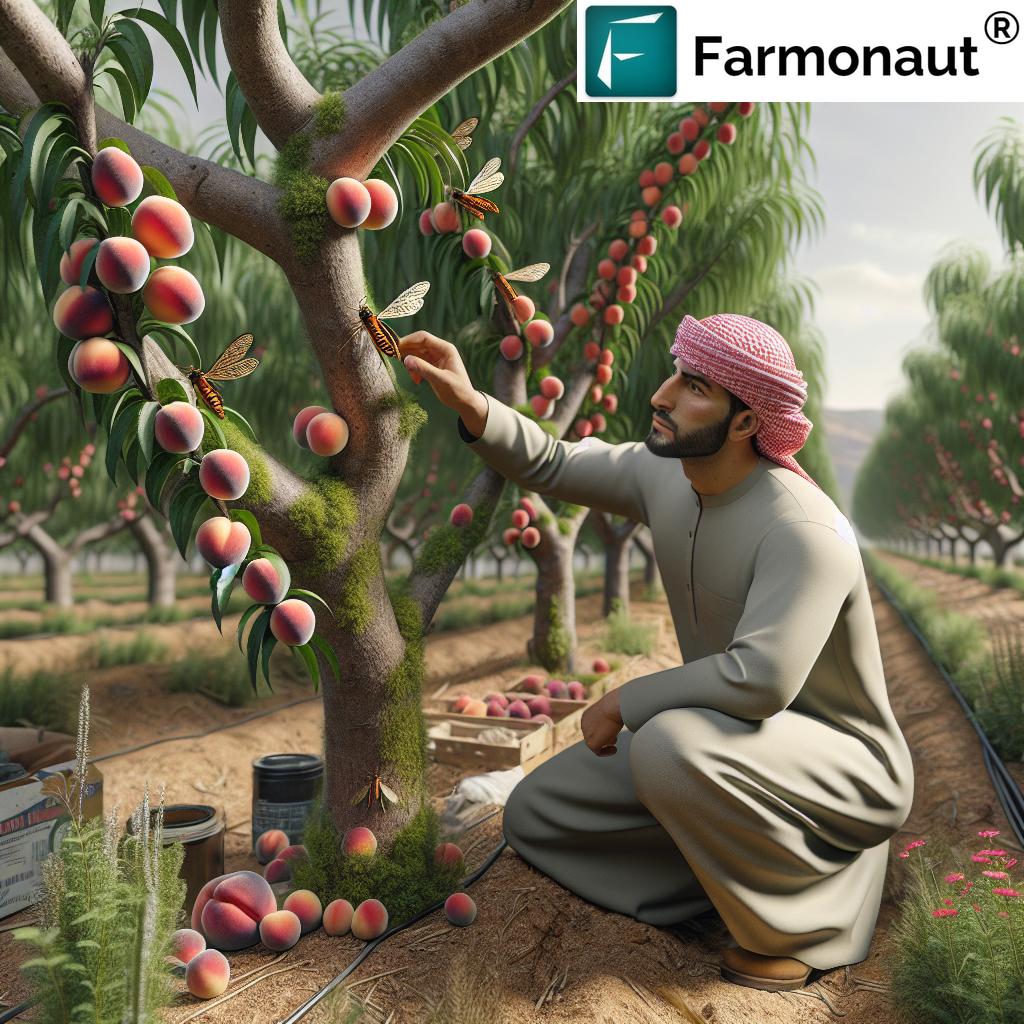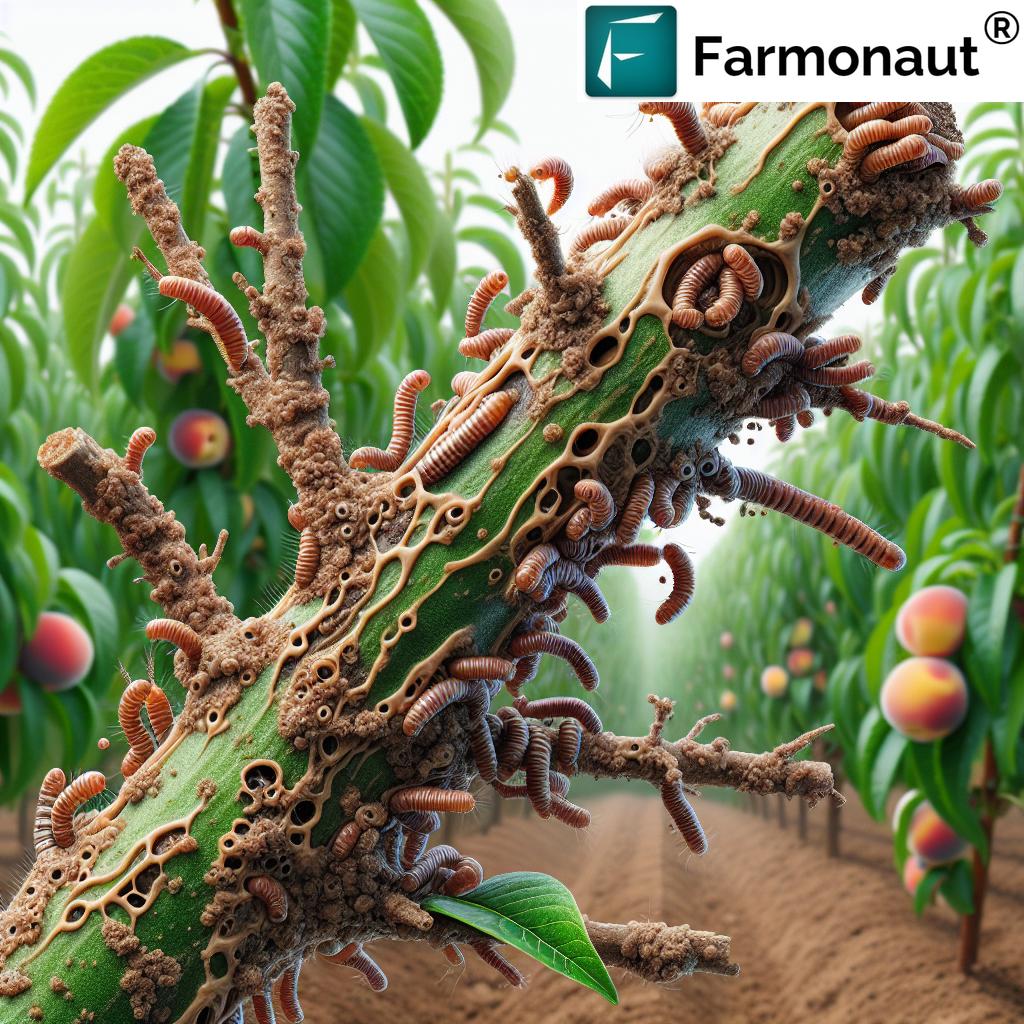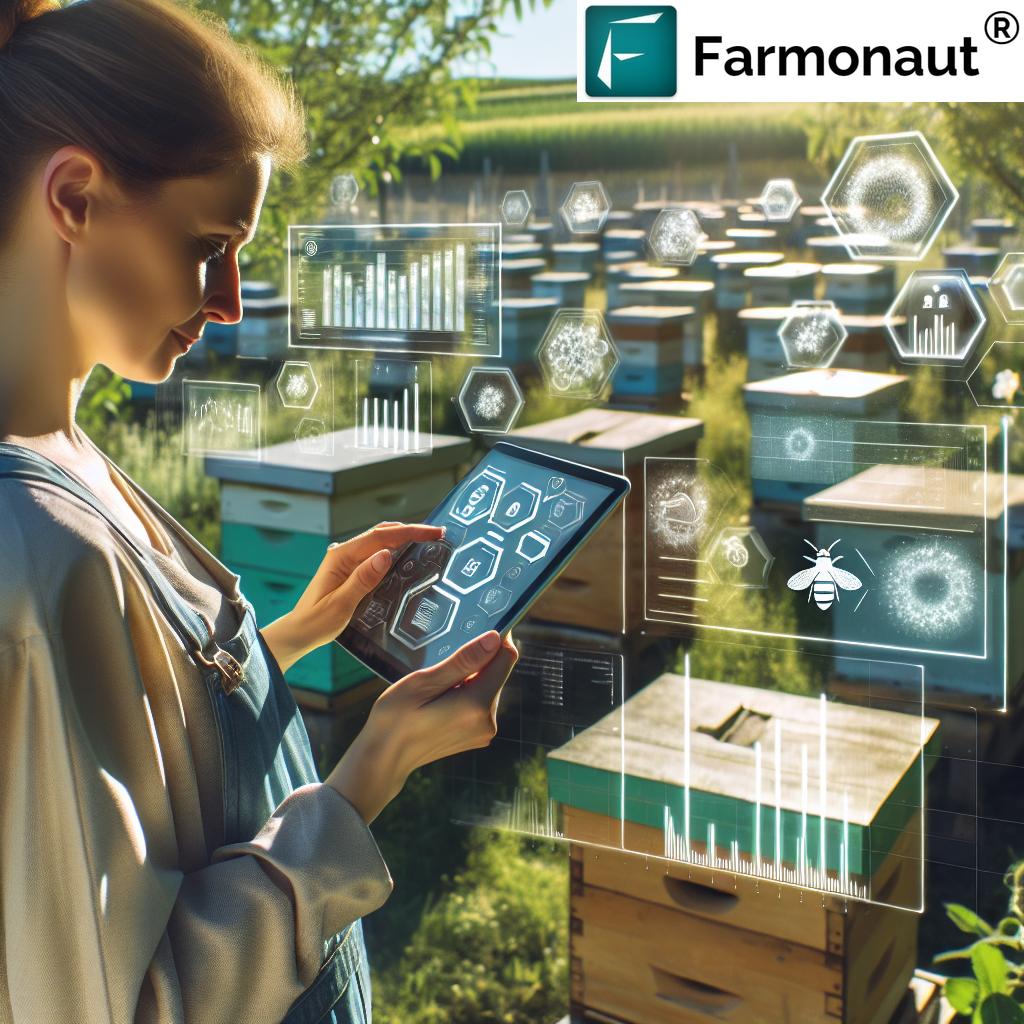Life Cycle of Peach Twig Borer: 7 Proven Control Strategies
“Peach twig borer larvae can cause up to 80% yield loss in unmanaged stone fruit orchards.”
Introduction
Peach twig borer (Anarsia lineatella) stands among the most destructive stone fruit pests in orchards across the world, attacking peaches, nectarines, plums, and prunes. For orchardists and growers, understanding the peach twig borer life cycle, and damage caused by its larvae, is essential to minimizing crop damage and optimizing effective management.
Without timely peach twig borer control, the damage from peach twig borer larvae can be severe, causing up to 80% yield loss in unmanaged orchards. This guide combines knowledge of the peach twig borer life cycle, identification, monitoring fruit borer activity, and the top 7 proven strategies for managing peach twig borer in stone fruit crops.
We also highlight how modern precision agriculture solutions—such as those we offer at Farmonaut—enable smarter, data-driven pest monitoring and decision-making for organic peach pest management and integrated approaches.
Looking for seamless integration of satellite-based pest monitoring?
Explore our robust Farmonaut API and visit our Farmonaut API Developer Docs for instant, real-time crop data—ideal for orchardists and agri-businesses seeking digital precision in pest and resource management.
Identifying Peach Twig Borer: Recognizing the Pest at Every Stage
Correctly identifying fruit tree borers is the cornerstone of any successful pest control program. The peach twig borer’s appearance changes markedly over its life cycle, from egg through larvae, pupa, and adult moth. Here’s what to look for:
- Eggs: Oval, about 1/30 inch (0.8 mm) long, yellowish-white to orange, and typically laid singly on leaves, twigs, shoots, or fruit.
- Larvae (Caterpillars):
- Young larvae: Whitish, thin brown bands, distinct black head, up to 1/2 inch (12 mm).
- Mature larvae: Chocolate brown with alternating dark & light bands around the abdomen.
- Characteristic feeding habits: Boring into shoots, wood, and fruit.
- Pupae: Oblong, brown to orangish, 1/4 to 2/5 inch (6-10 mm), found in organic litter beneath the tree or in protected places like bark crevices—without a cocoon.
- Adult moth: Small, 1/3 to 1/2 inch (8 to 12 mm); steel-gray forewings mottled with white and dark scales; pale-gray, fringed hindwings; a “snout-like” appearance due to prominent palpi.
Key tip: During spring and bloom, check for wilted shoots and frass (fine sawdust), especially at branch crotches and under bark—clues indicating overwintering peach twig borer activity.
Understanding the Peach Twig Borer Life Cycle
To enable effective peach orchard pest control, we must first understand the peach twig borer life cycle and behavioral patterns that drive infestations. The pest undergoes multiple generations annually—often three per year in many regions.
Main Life Stages of the Peach Twig Borer
- Overwintering (Larva within hibernaculum):
- First/second instar larvae overwinter in tiny “hibernacula,” excavated under thin bark on 1–3 year old wood, at pruning wounds, or in bark crevices.
- These sites feature “chimneys” of frass and wood chips.
- Spring Emergence & Feeding:
- In early spring, overwintered larvae emerge and feed on new buds, shoots, and developing leaves.
- Larvae bore into elongating shoots, causing “flagging”—wilted, dying terminals.
- Generational Flights:
- First generation: Adults emerge mid- to late-May, laying eggs on fruit, shoots, or leaves. Feeding occurs through late May-June.
- Second generation: Adults emerge mid-July, with some larvae overwintering, others continuing development. Attacks intensify on fruit or twigs.
- Partial third generation: Some years, an additional late August/September flight occurs, producing larvae that attack fruit and shoots before overwintering.
- Pupation:
- Larvae develop into pupae, often outside the host tree, in leaf litter, organic matter, or protected trunk crevices.
- Adult Moth Emergence and Egg Laying:
- Adult moths emerge, typically synchronizing their flights with host phenology (bloom and fruit development).
- Females lay eggs singly on smooth surfaces of twigs, shoots, or fruits.
Smart monitoring of each generation’s emergence is key—these phases dictate the timing of interventions for managing peach twig borer.
“Monitoring traps can reduce peach twig borer infestations by over 60% when combined with timely control strategies.”
Damage from Peach Twig Borer Larvae: Impact on Stone Fruits
Recognizing and quantifying the damage from peach twig borer larvae helps orchardists make essential management decisions, prioritize interventions, and estimate loss risk. Peach twig borer attacks cause:
- Bud and shoot damage: In spring, larvae bore into developing shoots and buds, leading to wilting, dieback (“shoot strikes”), and reduced future fruiting wood.
- Fruit damage: Later generations feed at the stem end of developing fruit (peaches, nectarines, plums, prunes), chewing under the skin, causing disfigured, unmarketable, and prematurely dropping fruit.
- Entry point for decay: Borer-induced wounds invite pathogens, compounding losses through fruit rot and decay.
- Losses escalate rapidly in untreated orchards, as population growth across multiple generations increases cumulative attack rates.
Example symptoms:
- Drooping, wilted shoot tips
- Frass and chewed tissue at twig crotches
- Entry holes and sticky gum near the fruit’s stem end
- Pale or brown “flagged” shoots that die back rapidly
- Discolored, softening fruit where larvae have fed
Peach Twig Borer Life Cycle and Control Strategies Table
| Life Cycle Stage | Stage Timing (Estimated Month) | Damage Caused | Common Symptoms | Monitoring Techniques | Recommended Control Strategies |
|---|---|---|---|---|---|
| Egg | May, July, Aug/Sep (gen. 1/2/3) | None | Small, yellowish/orange eggs on leaves, shoots, fruit | Inspect new growth for eggs; use hand lens; focus on smooth twig surfaces | Oil sprays at dormant/bloom; early insecticide at egg hatch; physical removal in small orchards |
| Larva | March–September | High: Bores into shoots and fruit; causes dieback, fruit deformity, decay entry | Wilted shoots, frass, holes at fruit stem, gumming, “flagging” terminals | Scouting for wilted tips, frass; spring/summer fruit examination; pheromone traps—for flight timing | Pruning/removal of infested shoots; early-targeted sprays (Bt, spinosad); support natural enemies; strict sanitation |
| Pupa | April–September | None | Oblong pupae in organic litter, protected bark | Rake/cultivate orchard litter; check bark crevices at trunk base | Sanitation (leaf litter/pupa removal); bark cleaning |
| Adult (Moth) | Mid–May, July, Sept (regional variation) | Indirect; females lay eggs for next generation | Small, gray/white moths; active dusk-dawn, seen in pheromone traps | Deploy pheromone traps early May; observe adult “flight” peaks | Pheromone disruption; time insecticide sprays post-flight; mass trapping in high-risk blocks |
Monitoring Fruit Borer Activity: Techniques and Timing
Precise monitoring fruit borer activity enables orchardists to act at the most vulnerable pest stages for maximum peach twig borer control success.
Best Practices in Monitoring
- Pheromone Traps: Place at bloom (early May); catch male adult moths—these track generational flight peaks and signal egg-laying windows.
- Shoot & Fruit Inspections: During spring, regularly examine wilted shoots and check base of flowers for young larvae, frass, or “flagging”. In summer, locate fruit with entry holes or gumming at the stem end.
- Bark Examination: Between fall and bloom, inspect thin sections of bark, especially in crotches of 1–3-year-old wood, for hibernacula (look for frass “chimneys”) and signs of overwintering peach twig borer.
- Record Keeping: Maintain seasonal pest diaries, mapping “hot spots” across orchard blocks for targeted intervention.
We at Farmonaut help orchardists pinpoint real-time changes in crop and canopy health using satellite-based crop health monitoring—so emerging infestation patterns in peach twig borer life cycle are easier to spot and act on early!
Want to integrate advanced fruit borer control into your orchard management? Check out our Large Scale Farm Management App—it’s perfect for keeping tabs on pest activity across many hectares with ease and precision.
7 Proven Peach Twig Borer Control Strategies
Effective, sustainable peach twig borer control relies on integrating several methods—timed to pest biology, orchard conditions, and your management philosophy. Here are the best 7 “problem-solving” peach twig borer life cycle control approaches.
-
1. Timely Orchard Monitoring & Data-driven Decision Making
- Use pheromone traps to track adult moth flights as soon as spring bloom begins.
- Pair with weekly scouting for larvae, eggs, and wilted shoots, prioritizing next-generation hotspots.
- Digitize samples and risks with satellite or app-based solutions to spot trends early (see Farmonaut app buttons above!).
-
2. Cultural Controls—Sanitation and Pruning
- Prune and remove wilted shoots below the damage to destroy feeding larvae.
- Clean up organic orchard litter (site of pupae) and remove bark hiding places.
- Winter bark brushing can physically disturb overwintering larvae and hibernacula in crotches, wounds, or crevices.
- Practice strict orchard hygiene to reduce survival between generations.
-
3. Biological Controls—Beneficial Parasitoids and Predators
- Support and conserve beneficials like Copidosoma varicornis, Hyperteles lividus (parasitic wasps), and Pyemotes ventricosus (mite).
- Minimize disruptive insecticide sprays to preserve these allies—they regulate populations over seasons.
-
4. Organic Peach Pest Management
- Apply organic sprays (e.g., Bacillus thuringiensis (Bt), spinosad, neem-based products) at bloom or during larval emergence for safe, residue-free control.
- Bt works best before larvae bore into shoots or fruit.
- Use oil sprays at the dormant stage to suffocate overwintered eggs/larvae.
- This approach supports market access for organic-certified stone fruits.
See our Carbon Footprinting Service to track and reduce input emissions for a sustainable, eco-friendly orchard.
-
5. Insecticide Applications for Chemical Control
- Target sprays at egg hatch or just as larvae emerge in early spring—before boring occurs.
- Best products: Spinosad (Entrust, Success), Methoxyfenozide (Intrepid), Diflubenzuron (Dimilin), or Bacillus thuringiensis (Bt).
- Always follow label instructions, rotate chemicals to reduce resistance, and avoid spraying during bloom to protect pollinators.
-
6. Mating Disruption and Mass Trapping
- In high-value blocks, deploy extra pheromone lures to impair male flight location of females—reducing egg laying and the next generation.
- Mass trapping can be combined with chemical/organic sprays for integrated pest management in orchards with persistent infestations.
-
7. Decision Support and Digital Tracking
- Leverage decision-support tools like Farmonaut’s AI and satellite imagery to monitor pest outbreaks and ecosystem health in real time.
- Geo-tag infestations, schedule spray alerts, and document infestation trends for precise, data-driven management.
- Blockchain-based traceability platforms help document organic and sustainable stone fruit management for consumer trust—see Farmonaut Product Traceability for details.
For orchards producing fruit for fresh market, juicing, or export, combining these strategies across the generations and stages of the peach twig borer’s life cycle is the gold standard for sustainable, profitable peach twig borer management.
How Farmonaut Can Support Effective Peach Orchard Pest Control
Modern precision agriculture, like the solutions we provide at Farmonaut, maximizes pest monitoring accuracy and supports smarter management—empowering you to protect your orchard’s profit and sustainability.
- Satellite-Based Crop Health Monitoring: Our multispectral imagery helps spot early symptoms of stress linked to pest infestations, such as patchy shoot dieback and abnormal canopy color—long before conventional scouting might find a problem.
- AI-Based Advisory: Our Jeevn AI analyzes pest population data, phenology, and weather to recommend custom peach twig borer control actions—like optimal timing for Bt or spinosad applications.
- Carbon Footprinting: Get real-time data to monitor your orchard’s environmental impact. We help you implement practices that minimize pesticide and fertilizer use, aligning carbon footprint reduction with market and regulatory demands.
- Product Traceability: Use our blockchain-powered system to verify every peach, nectarine, plum, or prune shipment is grown using eco-friendly, traceable methods—see our Traceability Solution page for more.
- Fleet Management: Our tools optimize orchard logistics, helping you efficiently deploy labor and application resources during bloom, larval emergence, and critical pest “activity” windows. Check our Fleet Management System here.
- Crop Loan and Insurance Support: Our platform provides satellite-based verification for insurance and loans, crucial if borer outbreaks threaten harvest yields. Visit Crop Loan and Insurance Solutions to learn more.
With affordable access via app, web, or API, Farmonaut empowers every grower—from smallholder orchardists to large-scale agri-businesses—with better data to face peach twig borer and other stone fruit pests with confidence.
FAQ: Managing Peach Twig Borer
What are the most obvious symptoms of peach twig borer infestation?
Look for “flagging” of shoot tips, wilted or drooping terminals, entry holes with gum at the fruit stem, and sawdust-like frass at twig crotches or bark crevices.
How many generations of peach twig borer occur each year?
Typically, three generations occur in warm regions—first in spring, the second in mid-summer, and a partial third in late summer to early autumn. Some larvae from the second and third generations overwinter.
When is the best time to apply chemical control?
Apply insecticides at egg hatch or when overwintered larvae are emerging and feeding—just before or at the beginning of each generational flight. Always avoid blooms to minimize risks to pollinators.
Can peach twig borer be managed organically?
Yes. Organic growers use Bacillus thuringiensis (Bt), spinosad, biological controls such as parasitoids, and sanitation to manage peach twig borer populations. Monitor closely and act before larvae enter shoots or fruit.
How can I use Farmonaut to aid my pest management?
Farmonaut provides satellite-driven crop health data, AI-based pest advisory, traceability, logistics, and resource management tools. These allow precise timing, rapid outbreak detection, and support integrated pest management at scale—all accessible via app, web, or API.
Farmonaut Subscription Plans
Conclusion: Integrated Management for Healthier Orchards
Effective protection against peach twig borer requires a deep understanding of its life cycle, precise monitoring, and the timely integration of cultural, biological, and chemical controls. By focusing on early detection of pest activity, supporting beneficials, and leveraging innovative digital tools like those from Farmonaut, orchardists can not only minimize damage but also promote sustainability, profitability, and market access for their peaches, nectarines, plums, and prunes.
Whether you are a smallholder, large commercial orchardist, or managing cooperative/NGO projects, applying these seven proven strategies with the support of advanced technology ensures resilient orchards for seasons to come.
Ready to modernize and secure your orchard against peach twig borer?
Start here with the Farmonaut App—and bring data-driven precision to every pest management decision.
Copyright © Farmonaut. All rights reserved. For expert satellite-driven precision agriculture solutions, crop health monitoring, farm management, pest detection, and traceability, trust Farmonaut—your partner in data-driven, sustainable orchard management.












